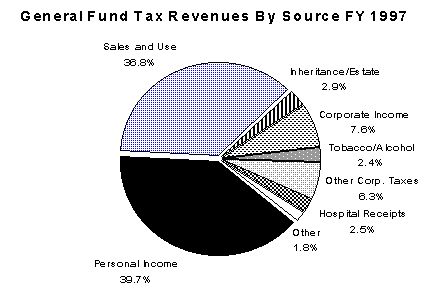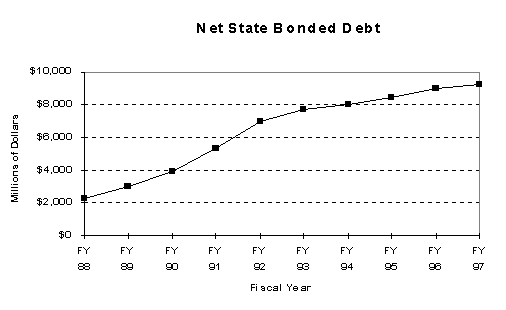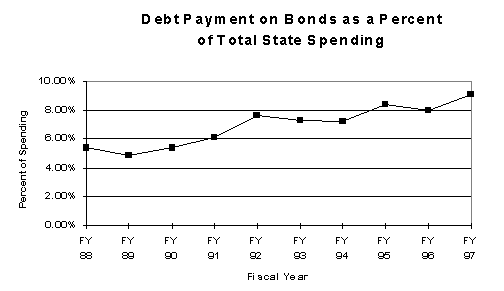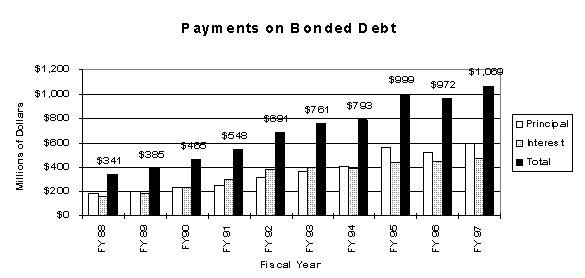

THE STATE'S FINANCIAL POSITION
Fiscal Year 1997 Performance - Operating Results
In Fiscal Year 1997, two closely watched state funds ended the year with revenues exceeding
expenditures. The General Fund ended the year with a surplus of $252 million, its largest surplus
in more than a decade, and the Transportation Fund generated a $47 million surplus. Although the
General Fund and Transportation Fund accounted for over 80 percent of the year's total
governmental transactions, the two funds alone do not provide a complete picture of the state's
performance. In addition to the Transportation Fund, there are other special revenue funds from
which the state provides grants and loans, undertakes housing projects, and provides other
specialized services that must be considered when evaluating the state's overall fiscal position for
the year.
When all state governmental funds are considered, Connecticut shifts from a surplus to a deficit position. In Fiscal Year 1997, the overall deficit for state governmental operations was $95 million. While this shortfall during the fiscal year is at its lowest level in a decade, it represents the continuation of a disturbing pattern of annual operating deficits. The deficits result from the state's continued reliance on borrowing to finance annual recurring expenditures. As a general rule, the state should take on debt only in cases where tangible assets with significant life spans are purchased. Because borrowing money carries an interest charge, debt financing increases the final purchase price of goods and services and, therefore, its use should be limited. In addition, the state debt is paid, in part, by future generations of taxpayers. Accordingly, items purchased with debt should provide some benefit to those future generations. Infrastructure projects for the construction of roads, bridges, and public buildings are examples of the appropriate use of debt financing.


On a cash basis of accounting, which is the present legal basis for budget purposes, General Fund spending increased by 4 percent between Fiscal Years 1996 and 1997. The economy has generated very little inflation with general price increases of just under 2 percent for the period. In addition, strong economic performance has actually led to a spending decline in welfare programs. The combination of low inflation and expanded employment opportunities has kept budget growth below historic levels. During the same period, General Fund revenues grew by slightly over 5 percent. Again, the revenue growth can be attributed to a strong economy.
Total governmental spending -- which includes the General, Special Revenue, and Debt Service funds -- increased by a negligible amount between Fiscal Years 1996 and 1997 on a Generally Accepted Accounting Principle (GAAP) basis. At the same time, total governmental revenues increased by 3 percent over the period.

In Fiscal Year 1997, half of the state's total spending was for education and related programs (including libraries and museums) and human services, such as nursing home care, medical care for the poor and disabled, and income support programs. Over 80 percent of the total General Fund revenues came from three sources: the personal income tax, the sales tax, and the corporations tax.


Overall Financial Performance - The Balance Sheet
In evaluating the state's financial position, there is a tendency to focus on a single year's operating
results. This approach does not provide an accurate overall, long-term picture of the state's financial
position. In addition to looking at one year's operating results, it is also important to consider the
state's balance sheet. The balance sheet discloses total assets and liabilities for each fund and
account group at the close of the fiscal year. A careful analysis of the state's balance sheet reveals
various financial challenges that confront the state. The General Fund balance sheet showed a
cumulative GAAP deficit of $670 million at the close of Fiscal Year 1997. This is an increase of
$30 million from last year. Over the past five fiscal years, the cumulative General Fund GAAP
deficit has increased by 33 percent. In other words, the state's balance sheet position has
deteriorated over time.
The main reason for the balance sheet deficit is the state's use of a modified cash basis of accounting for annual budget purposes. Under modified cash accounting, too much tax revenue is credited to a single fiscal year, and not all of the expenses incurred during the year are recorded. The overreporting of tax revenues, and the underreporting of state spending must be corrected on the balance sheet, which is prepared in accordance with GAAP. The cumulative impact of posting the correct revenue and expense figures is a General Fund deficit of $670 million.
People who invest in Connecticut's government through the purchase of bonds and notes evaluate the state's balance sheet position in making their investment decisions. As a general rule, large negative fund balances imply a greater risk of default and, consequently, investors demand a higher interest rate payment. A poor balance sheet position can translate into higher state interest costs on debt payments.
The way to guard against any further deterioration in the state's balance sheet position is clear: implement GAAP for state budgeting purposes. This would ensure that the proper amount of revenue is booked and expenditures are accounted for every fiscal year.
Debt Position
Connecticut is a high debt state, and that debt is growing. Net state bonded debt increased to $9.2
billion at the end of Fiscal Year 1997. This represented a 3 percent or $248 million increase over
the previous year. Per capita net bonded debt has now reached $2,774. In other words, every man,
woman and child in the state would have to pay $2,774 in order to eliminate the state's total bonded
debt. In addition to debt on bonds, the state has unfunded pension obligations ($6.4 billion),
unfunded payments to employees for compensated absences ($260 million), unfunded workers
compensation payments ($283 million), and capital leases ($49 million). These additional long-term
obligations bring total state debt to a staggering $16.3 billion, a $357 million increase over the
previous year. Based on the most recent figures on state finance compiled by the U.S. Census
Bureau, Connecticut ranks fifth in the nation in per capita long-term debt. This is not an acceptable
ranking for the wealthiest state in the country.

High levels of debt require high annual payments of principal and interest. These debt payments are made with dollars taken from taxpayers, and are not available to use for programs to benefit taxpayers. As debt payments consume a larger portion of a state's total spending, investors become more concerned about that state's ability to meet its future obligations. Because of the perceived increased risk of default, bond holders demand higher interest rates, which drive debt payments up. Today $1 of every $10 spent by the state goes to debt payment. This is almost double the level of 10 years ago. In Fiscal Year 1997, debt payments on outstanding state bonds passed the $1 billion mark, reaching a level of $1.1 billion.


Connecticut's debt level is too high and is growing. Items such as office equipment that should be paid from current resources are purchased with debt. As any consumer knows, it is more expensive to make purchases on credit. A state as wealthy as Connecticut should not be so quick to use the equivalent of a credit card to make normal annual purchases.